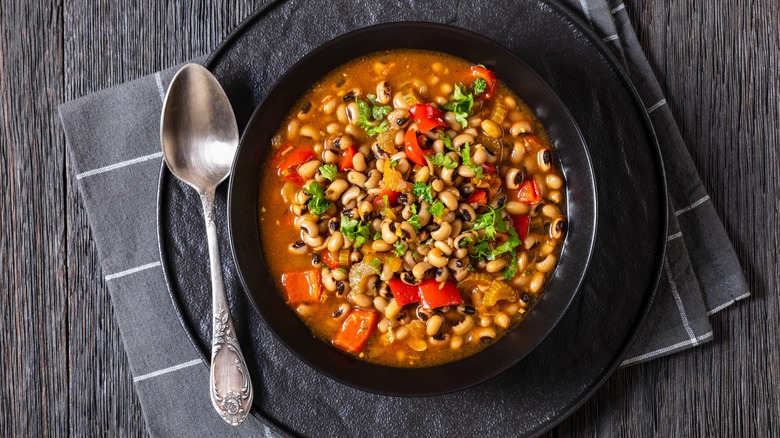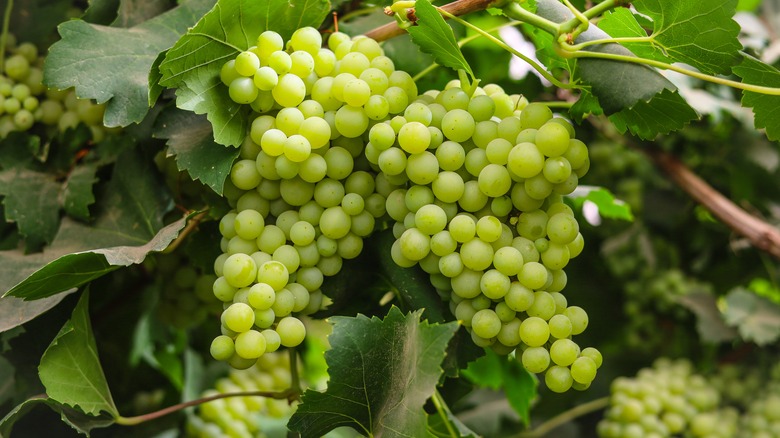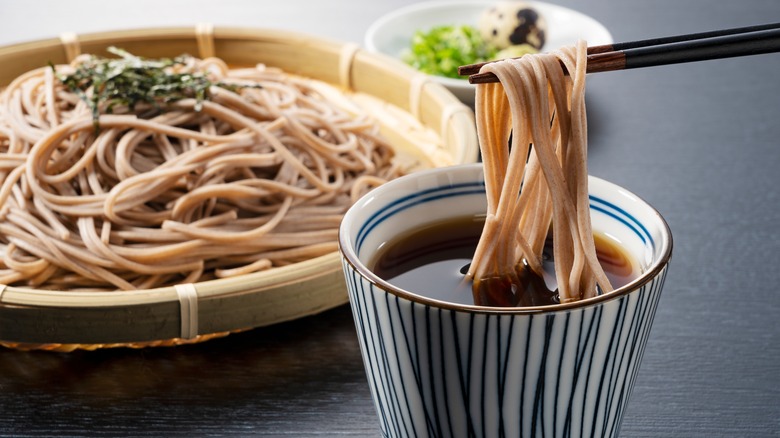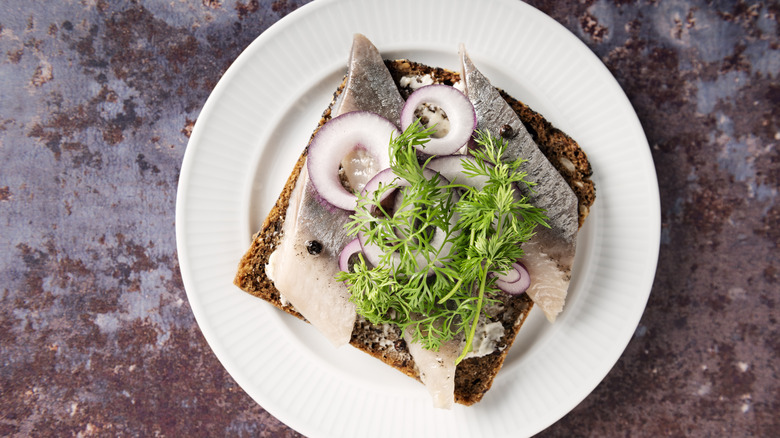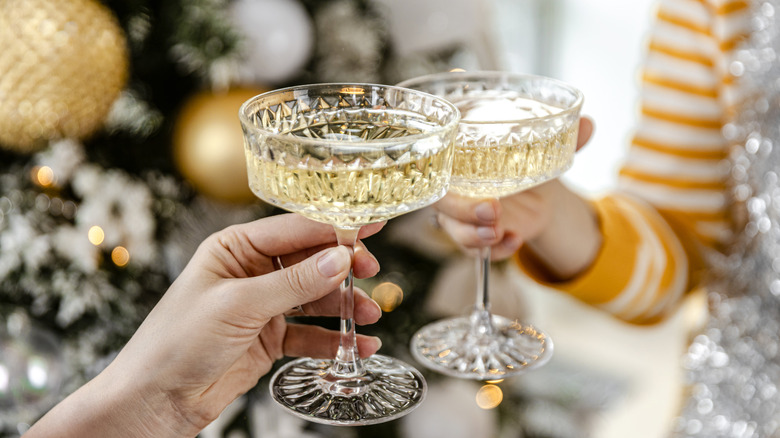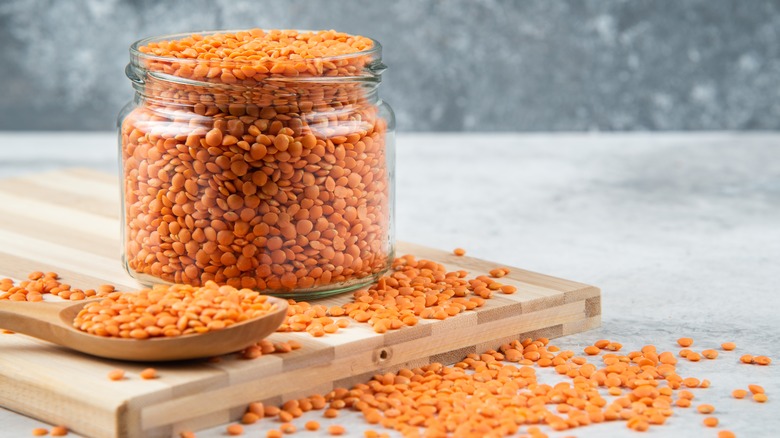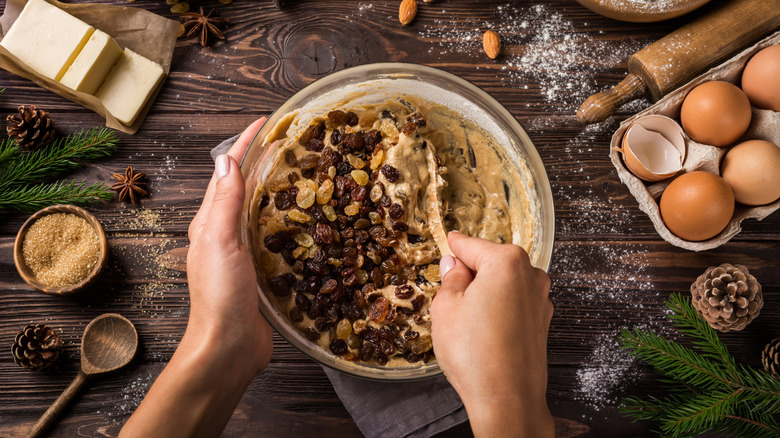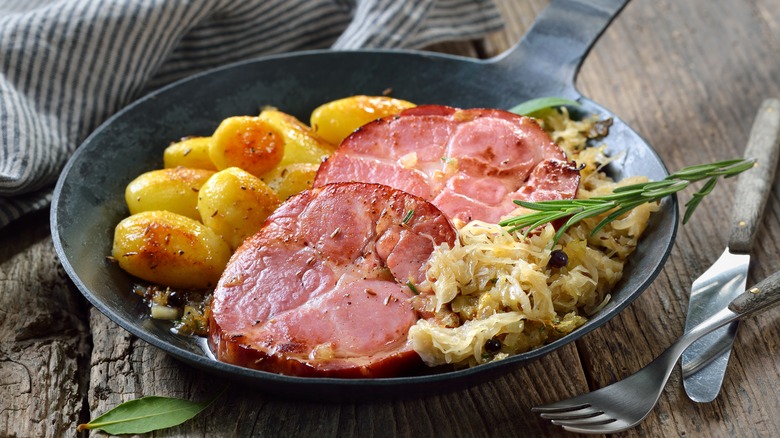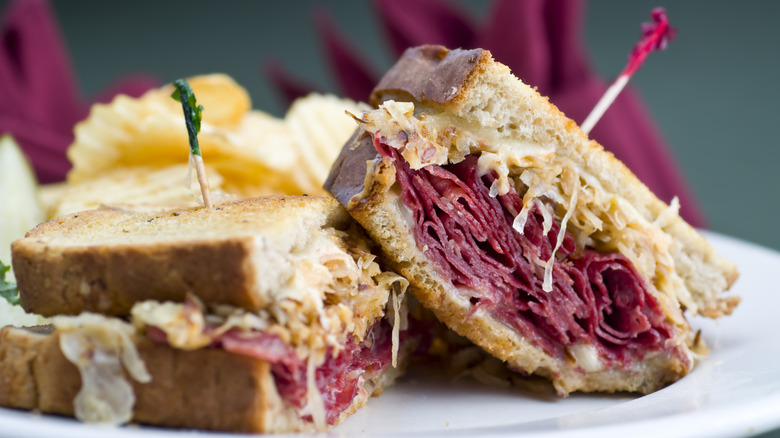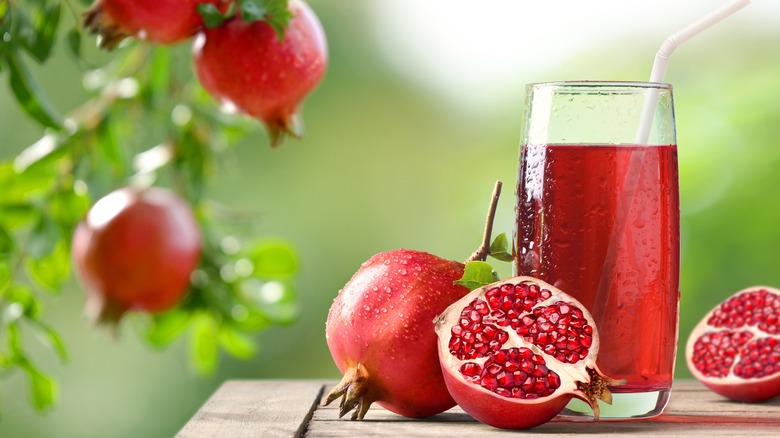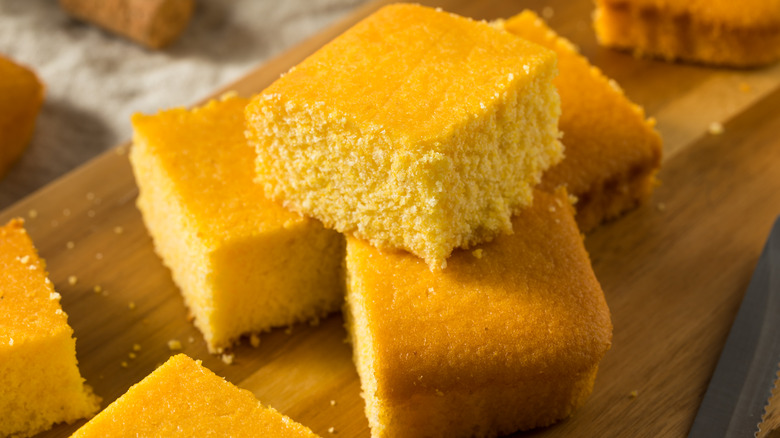12 Foods To Ring In The New Year With Some Luck
When the clock strikes midnight on New Year's Eve, we all hope the new season will bring us good luck and success — especially when it comes to nailing those New Year's resolutions! Eating is a huge part of the holidays and a great way to celebrate with family and friends. But, did you know that in many cultures certain New Year's dishes are believed to bring good luck? From hearty bean stews with roots in American Civil War history to Scottish raisin buns that represent prosperity and plenty, New Year's food traditions are fascinating and diverse.
In this New Year's food guide, we've researched festive traditions from all over the world — and some close to home as well — to discover the luckiest foods you can eat at New Year. Not a whizz in the kitchen? Don't worry! Most of these foods can be store-bought or whipped up at home using simple recipes, so you can spend more time relaxing when the new year rolls around.
1. Black-eyed peas
Eating black-eyed peas on New Year's Day is believed to bring good luck and is associated with several important moments in American history. During the American Civil War, black-eyed peas were a staple food in the South for surviving the winter. Southerners felt lucky to have these nutritious little beans to eat, especially when supplies were dwindling during the war.
Black-eyed peas were also reportedly eaten in celebration by newly freed African Americans when the 1863 Emancipation Act began on New Year's Day, furthering the association with prosperity and hope. In southern cuisine, you'll typically find black-eyed peas served on New Year's Day with collard greens. And, it's all about money: The black-eyed peas represent the shape of coins, while the greens symbolize the color of money.
One of the most popular recipes for black-eyed peas on New Year's is a southern dish called Hoppin' Josh or Hoppin' John. It's traditionally a one-pot dish made by stewing black-eyed peas together with onions, celery, and smoked ham. The result is warming and delicious — a perfect comfort food for cold weather. You can make it with tinned or dry black-eyed peas, although using tinned will reduce cooking time.
2. Grapes
The tradition of eating grapes for good luck on New Year's Eve originated in Spain and is a super fun way to countdown the bells. Tradition states that everyone should eat twelve grapes — one for each clock chime leading up to midnight — to bring good luck in every month of the new year. Exported from Spain in the 1900s, this practice is also popular in Mexico. Generally, the tradition involves scoffing white grapes as these are ripe in December.
A version of this New Year's ritual also exists in Portugal, but here they substitute fresh grapes with dried raisins. If you are partaking in this holiday tradition, make sure you've finished chewing by the time the New Year strikes. Superstition states that if you haven't eaten all your grapes you could be in for bad luck in the coming year.
If you're not a fan of the fresh variety, you can try some fun and easy grape recipes to liven up these lucky snacks. Try coating white grapes in melted chocolate, sticking them on skewers, and chilling them in the fridge to serve as a party snack. You could also freeze your grapes and add them as ice drops to a fruity cocktail.
3. Soba noodles
Served in a warming dashi broth, soba noodles are an important part of celebrating New Year in Japan. The noodles are a central ingredient in traditional Toshikoshi, which translates to "year-crossing" and symbolizes luck entering the new calendar year. Toshikoshi is traditionally eaten on New Year's Eve and this ritual is believed to date back as far as the 13th century.
Soba noodles are made from buckwheat, which is a hardy grain and is said to symbolize resilience and strength going into a new year. Once cooked and served in the broth, the noodles become soft and gelatinous and can easily be cut with chopsticks. This represents a fresh start and breaking ties with the old year. Tokishoki is also a perfect winter dish because of its rich, warming flavor, and is something you can easily make at home.
To create your dashi broth, you can use store-bought dashi powder or kombu kelp and katsuobushi bonito shavings, which are the main ingredients in authentic Toshikoshi stock. Dashi broth is quick to make and does not require hours of boiling, unlike many Japanese bone broths. Once heated, simmer your stock with mirin and soy sauce and then pour over the cooked soba noodles. Toshikoshi is usually garnished with chopped scallions and tempura flakes ,or you can add a kamaboko fishcake or two.
4. Herring
Fish is eaten at New Year's throughout different parts of the world and is prepared in a variety of ways. However, in Poland and Scandinavia, the specific fish of choice is pickled or smoked herring. This fish was associated with good luck in coastal areas of northern Europe because it could be fished in huge numbers and was a staple of the North Sea fishing trade. However, herring stocks could also be highly unpredictable so eating herring at midnight on New Year's Eve was meant to symbolically call up large herring shoals for the new year's catch.
Herring also became associated with good luck and prosperity because it could be effectively preserved — through pickling, salting, or smoking — and last through hard times. Eating herring at New Year was essentially inviting more good eating in the year to come. Fish scales are also associated with luck in Europe because they resemble pennies and herring's sparking silver coats are a great example of this.
If you head to a Scandinavian New Year's party, you can usually expect to find smoked herring served on a platter alongside other snacks, like pickles or Swedish meatballs. You can also buy pickled herring, or rollmops, in jars or pickle herring yourself at home by salting herring fillets in brine and then soaking them in vinegar and sugar for several days. It's delicious served alongside dark rye bread and sour cream.
5. Champagne
Champagne is probably the most well-known drink associated with celebrations, parties, and fresh new starts. Invented by accident in 17th century France, this delightfully bubbly drink is annually raised to toast the New Year throughout Western countries. According to scholars, drinking champagne — which was sold as a high-end drink for the noble classes – on New Year's was a way to feel like a noble yourself for the night. This, in turn, was supposed to bring luck and the possibility of future riches as you entered the new year.
While you can, of course, enjoy champagne as it comes, New Year's Eve is also the perfect occasion to break out the champagne cocktails. A French 75 recalls the celebratory European spirit of champagne and looks great served in a traditional champagne flute with a lemon twist on the side. You can make a French 75 by mixing gin, simple syrup, and lemon juice and then topping it up with champagne or prosecco.
However, if you really want to ring in the new year with good luck, a pomegranate champagne cocktail is the way to go. Pomegranates are a lucky New Year's food in their own right — more on this later — and adding a splash of fresh pomegranate juice to your champagne amps up the color and flavor of this classic drink. All you'll need is some pomegranate juice, a sprinkling of pomegranate seeds, a dash of Cointreau, and the bubbly of your choice.
6. Lentils
Snacking on round foods to bring prosperity is a common New Year's tradition in many countries around the world. In Italy, lentils are the circular food of choice to usher in a lucky new year. Lentils are associated with luck, wealth, and prosperity because of their round, coin-like shape, and their orange color. These delicious little legumes also swell during the cooking process, which suggests that your wealth will grow in the new year.
If you're celebrating New Year's Eve in Italy, you'll most often see lentil dishes being eaten just after midnight strikes. Lentils are cheap and can be cooked at home in a variety of ways. Traditionally, Italians serve New Year lentils with pork sausage or pig's trotter.
To cook the lentils themselves, Italian recipes usually start with a base of sautéed onions, carrots, celery, and tomato paste. The lentils are added to this mixture along with herbs like rosemary, bay, and thyme. Water is added to help the lentils break down creating a thick, stew-like texture for an effortlessly simple and satisfying dish.
7. Black bun
Scotland has a whole host of New Year — or Hogmanay — traditions that are believed to bring luck and prosperity. Hogmanay is a hugely important celebration in Scotland, sometimes even overshadowing Christmas. One New Year food that you may find in Scottish households is a black bun which are dense raisin cakes often given as gifts on New Year's – they symbolize eating well and not going without in the coming year.
Unlike other festive cakes, however, a black bun is traditionally baked with a layer of pastry on the outside. This makes it look more like a pie than a cake. When you cut into it though, the juicy raisin layers and brandy-infused sponge should still be moist underneath. Like other famous holiday desserts, such as plum pudding or Christmas cake, black buns are seasoned with ginger and cinnamon to give them a sweet, spicy taste.
Black buns are also associated with Scottish Hogmanay traditions, like first footing. This takes slightly different forms across Scotland but usually involves people visiting each other's houses before midnight on New Year's Eve and taking gifts of food and drink with them. First footers might enjoy a slice of black bun and a dram of whisky in each house to toast to a lucky new year.
8. Sauerkraut and pork
Sauerkraut and pork is the traditional dish eaten by Germans at New Year's. The dish is supposed to symbolize going forward into the new year because of the forward motion that pigs use to forage with their snouts. Sauerkraut is made from fermented cabbage — a green that pairs brilliantly with pork — and is a popular delicacy in Germany and parts of Eastern Europe. For instance, Estonians and Lithuanians also tuck into sauerkraut during New Year festivities.
Sauerkraut and pork dishes were also exported to America from Europe in the 1600s and are commonly eaten in Pennsylvania because of the high numbers of German and Dutch inhabitants. Like collard greens in the American South, sauerkraut is believed to be lucky because the shredded green cabbage leaves resemble currency. To serve a traditional German pork and sauerkraut pairing on New Year's Day, you can choose between pork chops or pork loin. A honey-glazed smoked ham is also a delicious option.
It's possible to make sauerkraut at home by fermenting chopped cabbage in brine. However, fermented foods are notoriously hit and miss — things like temperature can make a huge difference — so you may find it easier to buy sauerkraut and save yourself some time.
9. Corned beef
In the early modern period, Ireland was mainly known for exporting beef, rather than selling it at home. This made it hard to get corned beef and meant that enjoying a slice of this salty hash was reserved for special occasions. Irish families would traditionally eat corned beef on New Year's as a sign of how rare and extravagant the dish was. In doing this, they hoped to manifest some of this same abundance and luxury in the new year.
If you're wondering how to eat corned beef like the Irish, look no further than another Irish New Year's tradition that has since died out in most of the country. This is the tradition of eating bread and butter to celebrate the sustenance of bread and the luxury of butter as the new year approached. New Year's in Ireland was sometimes referred to as the Day of the Buttered Bread and included good luck rituals, like throwing a loaf of bread through the door and then taking it back or beating a loaf on the house walls. So, slap some corned beef on a delicious slice of buttered white bread and celebrate New Year's the Irish way.
10. Kransekake and Oliebollen
Looking like a ring-shaped coin is a very lucky sign when it comes to New Year's dishes, as round foods are associated with coins and with future wealth. In fact, in Denmark and Norway, they build a whole tower out of ring-shaped cake slices, known as a Kransekake, which is commonly eaten at celebrations, weddings, and New Year's. This impressive-looking tower has a chewy, cookie-like texture and is usually decorated with royal icing. It can also have up to 18 layers and can be made gluten and dairy-free, meaning it's ideal for people with intolerances.
Round foods are also an important part of ringing in the new year in the Netherlands, where oliebollen are a scrumptious part of the festivities. Oliebollen are deep-fried raisin doughnuts that are covered in powdered sugar. You could also bake a round German bundt cake or tuck it into a classic New York bagel for your New Year's Day brunch if you want to evoke some wealth in the new year.
11. Pomegranate
Pomegranate is considered a lucky New Year's food in Greece and Turkey and is said to symbolize plenty and prosperity because of the fruit's abundant, jewel-like seeds. As well as eating pomegranates on New Year's Eve, many Greek households use them as festive decorations and hang them on their front doors.
There is also a Greek tradition of smashing the pomegranates to symbolically open up the new year. According to tradition, fathers should take a pomegranate to church with them on New Year's Eve and, after knocking on the front door when they arrive home again, they should throw the pomegranate on the ground to spread the seeds.
As well as being good luck symbols, pomegranate seeds have a tasty, slightly tart flavor and are considered a winter fruit, so you can enjoy them fairly fresh during the festive period. They are commonly added to both sweet and savory foods and can be found decorating salads, sprinkled through rice, and as a topper for cakes and desserts.
12. Cornbread
Served mainly with soul food side in the American South, cornbread is a dense and savory cake that's eaten for good luck on New Year's. Cornbread's association with luck comes from the dough's beautiful golden color and its hearty, filling texture. Given that it's a southern staple, it's not surprising to learn that cornbread is generally served alongside black-eyed peas and collared greens, especially at New Year's. This lucky combo is supposed to represent gold and riches coming your way as the seasons change.
If you want to recreate a southern New Year's meal, you can usually whip up a batch of cornbread at home in less than 30 minutes by using a combination of flour and yellow cornmeal. This is mixed with eggs, milk, and a generous quantity of butter to create a moist starchy dough. Sugar can be added to taste depending on whether you like sweet cornbread or the salty savory kind.
To taste cornbread at its best, try eating it warm out of the oven with lashings of butter spread on top. This will give you a true understanding of cornbread's importance as a soul food staple.
Methodology
In the course of researching this piece, I looked a several lists and articles via reputable online sources. I discovered which foods various cultures across the world eat on New Year's Eve to bring in luck, and why. I then looked into how these foods are prepared for these celebrations. In addition, some of the foods on this list I have eaten or cooked with myself — champagne cocktails, lentils, sauerkraut, pickled herring. I am also familiar with Scottish Hogmanay traditions as I live in Scotland.

